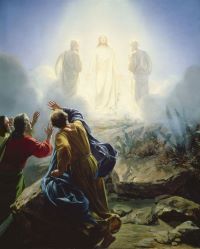Jesus took with him Peter and James and his brother John and led them up a high mountain where they could be alone. There in their presence he was transfigured; his face shone like the sun and his clothes became as white as the light. Suddenly Moses and Elijah appeared to them; they were talking with him. Then Peter spoke to Jesus. ‘Lord,’ he said ‘it is wonderful for us to be here; if you wish, I will make three tents here, one for you, one for Moses and one for Elijah.’ He was still speaking when suddenly a bright cloud covered them with shadow, and from the cloud there came a voice which said, ‘This is my Son, the Beloved; he enjoys my favour. Listen to him.’ When they heard this, the disciples fell on their faces, overcome with fear. But Jesus came up and touched them. ‘Stand up,’ he said ‘do not be afraid.’ And when they raised their eyes they saw no one but only Jesus.
As they came down from the mountain Jesus gave them this order. ‘Tell no one about the vision until the Son of Man has risen from the dead.’
Mt 17:1-9
After the shock of Jesus foretelling his death and resurrection (16:21-23), the Transfiguration reassures the faith of three disciples – Peter, James and John each of whom was destined for leadership positions in the early Church. Beholding the glory of Jesus, whose face shone like the sun and whose clothes were as white as light, they are convinced of his divine Sonship.
This event on Mt. Tabor is the New Covenant counterpart to Mt. Sinai, where God revealed his glory to Moses (Ex. 24:15-18) and Elijah (Kings 19:8-18), the representatives of the Law and the Prophets. Matthew’s Gospel makes constant reference to the Hebrew Scriptures and consistently reveals Jesus as the new Moses. In this episode the face of Jesus shone like the sun, a reminder of the appearance of Moses as he descended Mt Sinai with the Ten Commandments (Ex:34:29-30).
According to St. John Chrysostom (Homily on Matthew 56), Christ appeared with both Moses and Elijah to dispel the accusations that he transgressed the law and was a blasphemer. Jesus defended himself “do not imagine that I have come to abolish the Law or the Prophets, I have come not to abolish them but to complete them” (Matthew 5:17) and at the Transfiguration he brought before him those who shone conspicuous regarding the Law (Moses) and zealous for the glory of God – the Prophets (Elijah).
As at Jesus’ baptism the Father’s voice is heard (v. 5) however in this episode it is extended. The final injunction “listen to him” alludes to Deut. 18:15. Yahweh promised to raise up another prophet, so that just as Israel received instructions for worship and life through Moses, so must they obey the words of his prophetic successor. The Father confirms the divine Sonship of Jesus “this is my Son the beloved” and identifies him as the promised and long awaited prophet.
Paradoxically, Jesus is not just the prophet he is the proclaimed (Mark 1:1-11).
Anthony Cleary,
Director, Mission and Identity
